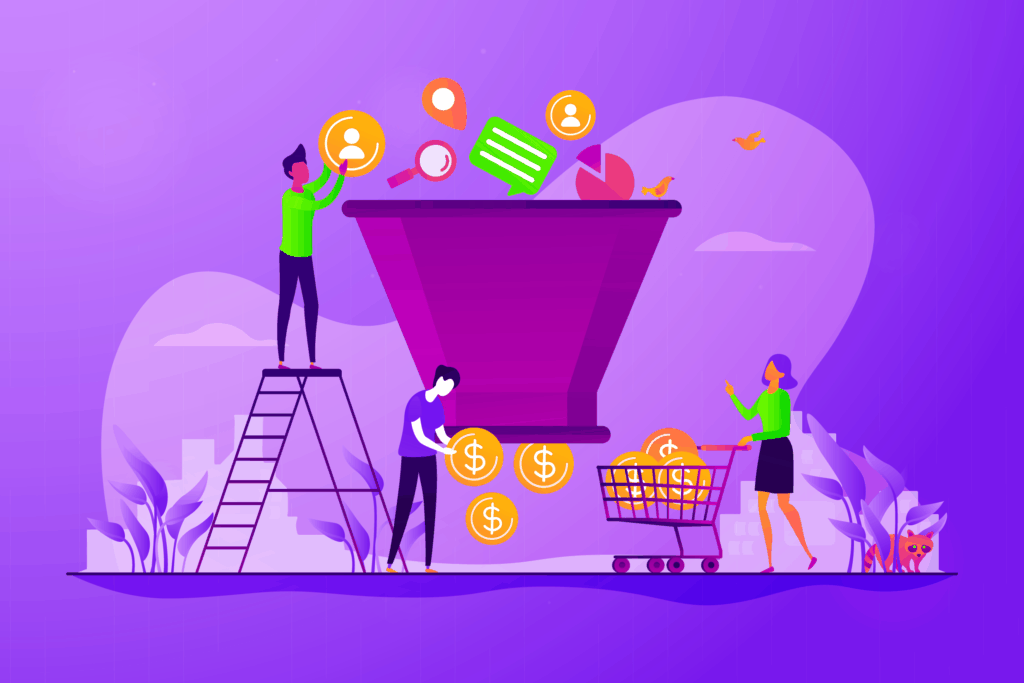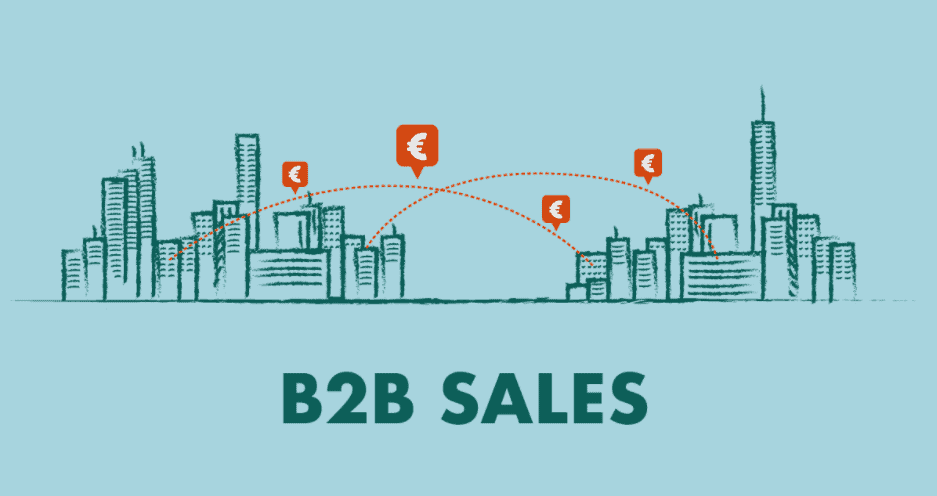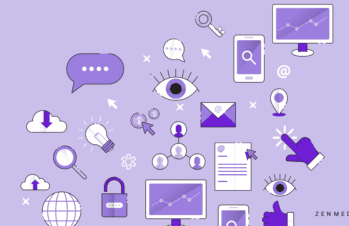Not terribly long ago, acquiring new business called for expensed lunches, in-person meetings, and the artful challenge of “landing a new client.” But just as with product offerings and service logistics, 2022 pushed us to pivot and reimagine how we do business — even how we acquire new business.
What were once courted lunches and in-person demonstrations are now virtual experiences and at-home lead generation. But the question many B2B industry veterans have is, yeah, but will it last? And if so, what does that mean for my sales approach?
Short answer: The B2B sales cycle has indeed evolved, and we’re not looking in the rearview mirror. But before you press your fingertips to your temple and wonder how you’re going to reinvent the wheel, relax; we’ve got you covered.
What Is a B2B Sales Cycle?
A B2B sales cycle refers to the series of steps that a business-to-business (B2B) seller goes through to sell their product or service to another business. The B2B sales cycle can be broken down into eight stages:
- Lead generation. The process of finding qualified leads and connecting with people who have expressed interest in your product or service.
- Discovery. Before you go on a first date (at least in the 21st century), what’s the first thing you do: Google them. Before your discovery call, you’re doing the tedious research necessary to secure a lucrative deal.
- Qualification. Finally, “the first date,” or the sales call of a prospective lead. They will be assessing you and your company’s qualifications just as much as you are assessing them.
- Pitch. Understanding how you and your services or product will fit seamlessly into their business equation.
- Objection handling. Dealing with the initial “no.” Very few clients will sign or buy on the spot; how we nurture the relationship moving forward is key.
- Closing. As the name suggests, it’s how you end the call with free perks or added value.
- Follow-up. Leave a good impression by following up with your client.
- Check-In. Keep the dialogue going with regular check-ins; nothing fancy, a simple email asking about their season in business is fine.

The Importance Of a Focused B2B Sales Cycle
You have likely been on both sides of the B2B sales cycle. In a simple, eight-step sequence, we’ve outlined what a B2B sales leader must do to experience success:
- Establish credibility
- Build and maintain rapport, trust, and connection
- Develop a mutually beneficial relationship
If you haven’t already, allow us to connect the dots: success is more readily available once you can:
- Provide credentials and proven results
- Demonstrate business acumen and industry relevance
- Leverage avenues of communications
The most impactful ways to do all of the above while also producing ROI include:
- Investing in your public relations
- Leveraging tools in communication and media
- Adopting new technology
If you are slow to maximize available resources, you could leave opportunities on the table or harm your brand credibility.
Related: How to Keep the Momentum Going on a Successful B2B PR Campaign
8 Ways the B2B Sales Cycle Has Changed
Technology has revolutionized the way businesses operate, interact, and make decisions. The traditional methods of B2B sales have been replaced by a more dynamic, efficient, and customer-centric approach. Here’s how the B2B sales cycle has changed and how businesses can adapt to the new trends.
1. The buyer is in control.
A B2B buyer is someone who represents a business that is purchasing goods or services from another business. The traditional sales approach, which relied heavily on cold calling and outbound marketing, is no longer effective. New buyers now have access to a wealth of information online, and they conduct extensive research before making a purchase decision. In fact, studies show that buyers complete up to 70% of the B2B sales cycle before even speaking to a sales representative. To succeed in this new environment, businesses must shift their focus to inbound marketing and provide valuable, educational content that addresses their customers’ pain points.
2. Stakeholders prefer a digital reality.
According to the global consulting firm, “More than three-quarters of buyers and sellers prefer digital self-serve and remote human engagement over face-to-face interactions.”
While most businesses were leaning toward a remote landscape, this means embracing the change by building credibility and community online is all the more important. As a PR agency with roots in social media marketing, we’ve evolved with the changing trends and have seen what has a lasting impact on our industry.
3. B2B buyers are making big online purchases.
Something new we’ve seen as a result of the past year is a B2B buyer confidence change. Previously, buyers would make small-ticket purchases, but now they are ready to spend five figures (even more) in the B2B space. Reportedly, “70 percent of B2B decision-makers say they are open to making new, fully self-serve or remote purchases in excess of $50,000, and 27 percent would spend more than $500,000.” B2B industry leaders also share that digital selling is as effective as warm leads, meaning your company can’t afford to skimp or gloss over the value of a digital connection.
The solution is connection and community; rinse and repeat. Having a beautiful website and a handful of reviews doesn’t cut it in 2022. To succeed in an oversaturated market, your company should be offering a superior digital experience. From how visitors engage with your website to how you position your brand on social media, all published content should have a call for action or opportunity for engagement.
3. Video and live chat are the mediums to embrace.
Love it or hate it, Zoom and video conferencing tools are here to stay. But even someone with limited engagement can attest to Zoom fatigue and the temptation to take calls with their video off. Nevertheless, B2B sales are being held via video conferencing, and it will be the sales leader’s job to build a memorable experience.

Super Office shared the following stats:
- Only 29% of buyers want to talk to a salesperson to learn more about a product,
- 57% of buyer decisions are made before buyers even pick up a phone to speak to a supplier,
- And, 34% of salespeople admit that closing deals are getting harder.
In addition to creating a warmer, more engaging virtual experience for leads, it’s time to rip off the Band-Aid and adopt the power of artificial intelligence, or AI. With tools like LivePerson, you can be accessible for extended business hours, ensure quality assurance, and limit human error.
4. Transparency builds trust.
There was a time when an air of mystery surrounded a product’s pricing and availability. Not today — buyers want the guesswork taken out of the business acquisition. Writer Amanda Mercer of Drift shared, “Everlane made a connection with me that was bigger than their product. Using phrases like, “radical transparency” and “simple basics sourced from ethical materials,” they told me exactly how their products are made and made me feel like I was joining them in a movement to push towards a more sustainable future.”
What is the aspirational message or experience you’re selling to fellow business owners? Is it the idea of cutting-edge technology with astonishing results? Do you promise a niche-focused method when someone does business with you? Whatever the case, a unique visitor shouldn’t be on a cat-and-mouse hunt for information. Instead, lend a high level of transparency related to your mission, partnerships, and philosophy — and have the published testimonials, credentials, and B2B PR to back it up.
5. The importance of personalization.
With so much competition in the marketplace, businesses must find ways to differentiate themselves from their competitors. One effective way to do this is by personalizing the customer experience. Buyers want to feel like they are valued and understood, and businesses that can deliver on this promise will win their loyalty.
Personalization can take many forms, from targeted email campaigns that address specific pain points to customized product demos that showcase how a product can solve a customer’s unique challenges. By tailoring their messages to each lead’s specific needs and interests, businesses can build stronger relationships with customers and increase the chances of closing a sale.
One of the key benefits of personalized sales and marketing messages is that they help build customer trust and credibility. When a sales rep takes the time to understand a customer’s unique needs and challenges and then provides tailored solutions that address those needs, the customer is more likely to view that rep as a trusted advisor rather than just another salesperson. This can lead to a longer-term relationship between the customer and the business and increased customer loyalty and repeat business.
6. The rise of social selling.
Social media has become an essential tool for B2B sales professionals. Platforms like LinkedIn provide a wealth of networking opportunities and enable sales reps to establish relationships with potential customers. By building a B2B social media marketing strategy, sales reps can leverage valuable content and engage with prospects. Reps can then build trust and establish businesses as an industry thought leaders.
One of the key benefits of social selling is that it allows sales reps to connect with prospects in a more natural and authentic way. Rather than sending cold emails or making unsolicited calls, sales reps can use social media to engage with prospects on a more personal level, sharing relevant content and insights that help to build trust and credibility over time. However, social selling requires a careful balance between being personal and professional. Sales reps must be mindful of their online presence and ensure that they present themselves in a way consistent with their company’s brand and values.
7. Mobile optimization is a must.
As more and more people use their mobile devices to conduct business, it’s essential that your website is optimized for mobile users. This means ensuring that your site is responsive, loads quickly, and is easy to navigate on a small screen. Failure to do so could result in a high bounce rate and lost sales opportunities.
By prioritizing mobile optimization, businesses can ensure that their digital assets are accessible to the growing number of people who use mobile devices to browse the web, and can also improve their search engine rankings, ultimately driving more traffic and leads to their website.
8. Data is driving decisions.
Data is now more important than ever in the B2B sales process. By tracking and analyzing customer behavior, businesses can gain valuable insights into what works and what doesn’t. This data can be used to refine marketing strategies, improve product offerings, and enhance the customer experience.
One of the key benefits of data-driven decision-making is that it takes the guesswork out of the sales process. Instead of relying on hunches or anecdotal evidence, businesses can use hard data to inform their decisions. This can lead to more effective marketing campaigns, more targeted sales pitches, and, ultimately, more closed deals.
Of course, data alone is not enough. Sales reps must also be able to interpret and act on the insights that data provides. This requires a combination of technical skills, such as the ability to use analytics tools and software, and soft skills, such as critical thinking, communication, and creativity.
Wrapping up
We’re moving toward a more digital world. And in such a world comes opportunities for growth. If you don’t want to leave money on the table or be made to feel left behind, there has never been a better time to embrace technology, digital communications, and online communities to stay relevant in this new world of B2B sales.
Looking to stay ahead of the curve and continue to thrive in this new environment? Contact us today!





